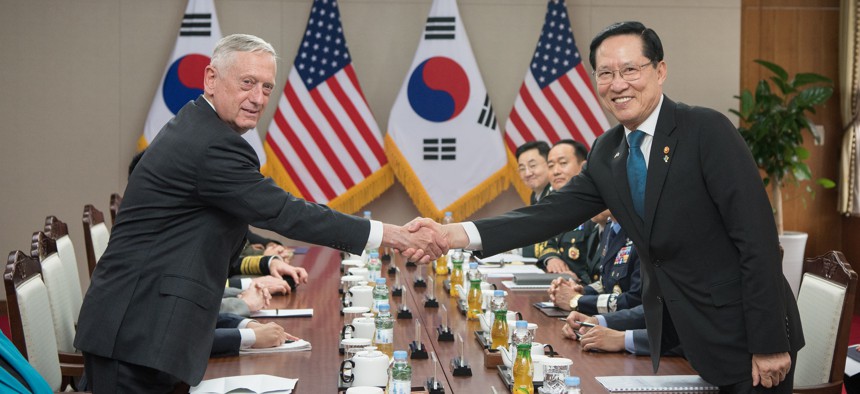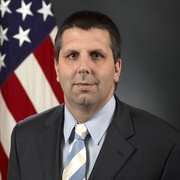
Secretary of Defense Jim Mattis meets with Song Young-moo, minister of national defense for the Republic of Korea, in Seoul, South Korea, June 28, 2018. DoD photo by Army Sgt. Amber I. Smith/Released
Here’s the Real Value in the U.S.-South Korean Alliance
As the U.S.-ROK Security Consultative Meeting convenes for a 50th time, it's worth reviewing the annual meeting's record of accomplishment.
Over the last two years, there has been much attention, rightly so, devoted to the remarkable developments around North Korea. This includes the events surrounding the XXIII Olympics in PyeongChang, the two inter-Korean summits, and the unprecedented Singapore Summit between President Trump and Kim Jong Un.
With all of the attention on machinations involving Pyongyang, it is important that we do not ignore an important bilateral milestone that will occur between Washington and Seoul this week, when Secretary of Defense James Mattis meets with his Korean counterpart, Minister Jeong Kyeong-doo. This meeting will mark the 50th anniversary of the U.S.-ROK Security Consultative Meeting, known as the “SCM." Often followed closely only by defense policy analysts and Korea watchers, the success of the SCM in managing, adapting, and advancing the alliance over the past half-century should not be overlooked. Preceded each year by thousands of hours of staff work to resolve and shape issues before the American secretary and Korean minister convene, this is the forum where the two sides establish a common understanding of threats to the alliance, promulgate policy direction to U.S. and ROK forces, and plan future operations.
The origins of the SCM lie in provocative actions by Pyongyang. In the midst of the heightened tensions on the Korean Peninsula in 1968 caused by North Korea’s seizure of the USS Pueblo, the SCM (then called the “Annual ROK-U.S. Defense Official Meeting”) was born. The secretary and minister sat down as equals, which reflected how the relationship was beginning to move from a "client-patron" relationship into a true partnership. At the 10th SCM in 1977, the U.S.-ROK Combined Forces Command, or CFC, was established, which today is the most integrated combined (meaning multinational) defense command in the world. One year later, the two allies launched a similar meeting for their top uniformed officers, called the Military Committee Meeting, or MCM, led by the two respective chairmen of the Joint Chiefs of Staff. The MCM now meets each year shortly before the SCM and serves as the mechanism for the two uniformed militaries to feed into the SCM process.
Taken together, these two fora and the combined U.S.-ROK command have become the foundation of the complex, yet highly effective defense system we know today on the Korean Peninsula. They enable the close year-round cooperation between our two militaries, defense officials, diplomats, intelligence officers, and defense industries. This structure, complemented by the United Nations Command, which is charged with enforcing the armistice, helps ensure the alliance is postured effectively to meet evolving threats to security on the Korean Peninsula and works to deepen alliance cooperation while resolving areas of difference.
And it works. For decades, the SCM has helped deter the DPRK from successful military attacks. It also helped produce other important results. In that time, the Alliance has acquired and developed weapons capabilities that help form the basis of conventional superiority that it now possesses over the North Korean threat. The Alliance has developed a tailored deterrence strategy to prevent North Korea from using weapons of mass destruction. It has also formulated alliance capabilities and responses to address asymmetric threats from North Korea.
In 1994, the SCM played a key role in the handover of day-to-day operational control, or OPCON, to the ROK, effectively giving Seoul responsibility for the defense of Korea during armistice, and later in formulating a conditions-based plan for a future wartime OPCON transfer. The SCM has helped the Alliance establish an important counter-provocation plan to govern responses to military threats posed by the DPRK below the threshold of war. It helped the Alliance to successfully manage a complex and difficult consolidation and modernization of U.S. forces on the peninsula. And, the SCM promotes a “Global Korea” whereby Korean forces are increasingly deployed to critical multinational and extra-Peninsula missions that help reinforce key international norms.
The SCM also provided a forum to help manage serious crises within the alliance, such as the potential withdrawal of American forces in the late 1970’s and issues involving Iraq in the early 2000’s.
Over time, other structures that encompass broader elements of the relationship have developed to further strengthen alliance, including a regular “2+2” meeting between the secretaries of state and defense and their Korean counterparts (often held immediately after the SCM); trade mechanisms embodied in the KORUS Free Trade Agreement; the 123 agreement which governs our relationship on civil nuclear issues; and a bilateral space agreement — the first of its kind in Asia.
This year, the SCM agenda will cover a full complement of challenges, befitting an alliance facing the realities of the 21st century. Secretary Mattis and Minister Jeong will have to confront complex issues such as alignment on North Korea policy, status of OPCON transfer, the possibility of resumption of US-ROK exercises next year, while conducting a wide-ranging examination of alliance capabilities and gaps. They will also likely engage in private discussions concerning the Special Measures Agreement, which establishes commitments for burden sharing between the allies.
Related: Curtailing Korean Exercises Comes at a Price, Says USMC Commandant
Related: Moon Brings Korean Peninsula One Step Closer to Peace
Given the many challenging issues that confront the alliance, it is healthy and natural to consider whether changes are necessary to the structures that underpin it. But on this anniversary, especially when contemplating the future direction of the alliance, we should be reminded that the SCM and its associated structures have proven both their value, adaptability, and versatility over time. Since 1968, it has formed the core of a framework that has grown, matured, and evolved dramatically, in both defense and non-defense sectors alike, to become one of the great alliances the world has ever known. This 50th SCM is an opportunity to celebrate this progress and plan for the future. The alliance’s many supporters on both sides of the Pacific will be actively engaged in efforts to promote even more success.
The opinions expressed in this commentary are solely those of the author and do not necessarily reflect the views of any current or previous employer, company, organization, or government agency.




